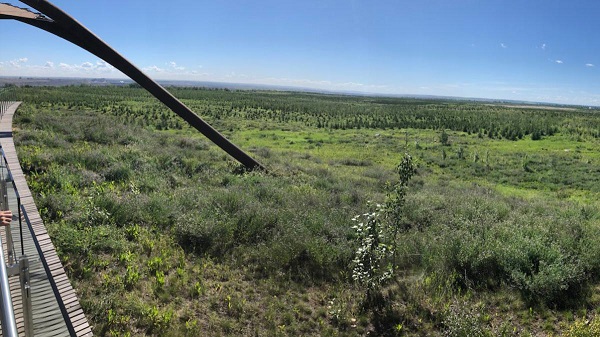Environment
Climate Alarmists Want To Fight The Sun. What Could Possibly Go Wrong?

 From the Daily Caller News Foundation
From the Daily Caller News Foundation
What should we say when one of America’s pre-eminent media platforms endorses a plan so fraught with unknowns and pitfalls it invites potential global catastrophe?
That’s what the editorial board at the Washington Post did on April 27 in a 1,000-word editorial endorsing plans by radical schemers and billionaires to engage in various efforts at geoengineering.
The Post’s editors engage in an exercise of saying the quiet part out loud in the piece, morphing from referring to monkeying around with the world’s ability to absorb sunlight as “a forbidden subject,” to concluding it is “indispensable” and “urgent” in the course of a single opinion piece. Sure, why not? What could possibly go wrong with such a plan?
What could go wrong with plans to, say, block sunlight with thousands of high-altitude balloons? Or with a plan that involves spraying the upper atmosphere with billions of tons of sulfur particles? Or with a plan to spend trillions of debt-funded dollars to build a gargantuan shield placed in stationary orbit in outer space?
The editors are so cocksure in their arrogance that they even admit some such concepts have already been tried out, writing, “Climate geoengineering is so cheap and potentially game-changing that even private entrepreneurs have tried it out, albeit at small scales.”
The “small scale” experiment to which the editors refer took place in Baja, Mexico, where researchers launched two large balloons filled with sulfur dioxide particles into the stratosphere. The goal was to measure the sun-dimming effects of the sulfur dioxide, a real, actual pollutant that the Environmental Protection Agency and regulators all over the world have spent the last half century attempting to remove from the atmosphere.
It turned out that Luke Eisman, an entrepreneur who financed the experiment, launched the balloons without seeking prior approval. When Mexican officials found out it had been conducted, they quickly moved to ban such geo-engineering projects on the grounds that they violate national sovereignty. Reuters reports that Mexico’s environment ministry statement said it would seek a global moratorium on such geoengineering projects under the Convention on Biological Diversity.
But despite such concerns in Mexico, here come the Post’s editors advocating we simply just have to trust the science. You know, like we trusted the “science” of COVID vaccines and the “science” of locating giant offshore wind farms in the middle of a whale migration corridor off the Northeast coast, right? Sure. After all, what could go wrong?
The editorial writers go on to cite a similar, larger scale project being promoted by climate-engineering scholars David Keith at the University of Chicago and Wake Smith at Yale. These gentlemen propose to try to lower temperatures by spewing out 100,000 tons of sulfur dioxide – again, a real pollutant humanity has worked decades to eliminate – at an annual cost of $500 million (no doubt to be paid for by more taxpayer debt) using what they refer to as “15 souped-up Gulfstream jets” to create what could accurately be called chemtrails.
In a piece published in February at the MIT Technology Review, the scientists say the project could be mounted as soon as five years from now, which we should all probably consider a threat rather than a mere projection.
Talk of mounting similar geoengineering projects has been ramping up in recent years. In 2021, Bill Gates said he was investing in a project based at Harvard University to spray tons of calcium carbonate particles into the stratosphere above Scandinavia, but the project was ultimately cancelled due to understandable outrage from indigenous groups and environmentalists.
Fellow billionaires Jeff Bezos and Facebook co-founder Dustin Moskovitz have also plowed millions into bioengineering projects.
But until recently, the thought of mounting projects designed to block out sunlight was, like the agenda to intentionally reduce the global population, a subset of their agenda that climate alarmists have tried to keep mainly under wraps. The reason is obvious: Whenever such radical and frankly dangerous ideas are made public, people tend to look at one another and ask, “who in the world would want to do that?”
Now come the members of the Washington Post editorial board, joining Gates and Bezos and Moskovitz in answering that question. Way to go, folks.
David Blackmon is an energy writer and consultant based in Texas. He spent 40 years in the oil and gas business, where he specialized in public policy and communications.
Energy
B.C. Residents File Competition Bureau Complaint Against David Suzuki Foundation for Use of False Imagery in Anti-Energy Campaigns

From Energy Now and The Canadian Newswire
A group of eight residents of Northeast British Columbia have filed a formal application for inquiry with Canada’s Competition Bureau, calling for an investigation into the David Suzuki Foundation’s (the Foundation) use of false and misleading imagery in its anti-energy campaigns.
The complaint alleges that the Foundation has repeatedly used a two-decade-old aerial photograph of Wyoming gas wells to falsely depict modern natural gas development in B.C.’s Montney Formation. This area produces roughly half of Canada’s natural gas.
Key Facts:
- The misleading image has been used on the Foundation’s website, social media pages, reports and donation appeals.
- The Foundation has acknowledged the image’s true source (Wyoming) in some contexts but has continued to use it to represent B.C. development.
- The residents claim this materially misleads donors and the public, violating Section 74.01(1) of the Competition Act.
- The complaint is filed under Sections 9 and 10 of the Act, asking the Bureau to investigate and impose remedies including ceasing the conduct, publishing corrective notices, and returning proceeds.
Quote from Deena Del Giusto, Spokesperson:
“This is about fairness and truth. The people of Northeast B.C. are proud of the work they do to produce energy for Canada and the world. They deserve honest debate, not scare tactics and misleading imagery used to raise millions in donations. We’re asking the Competition Bureau to hold the David Suzuki Foundation to the same standard businesses face: tell the truth.”
Background:
Natural gas development in the Montney Formation supports thousands of jobs and fuels economic activity across the region. Accurate public information is vital to informed debate, especially as many Canadians live far from production sites.
SOURCE Deena Del Giusto
Canadian Energy Centre
Alberta oil sands legacy tailings down 40 per cent since 2015

Wapisiw Lookout, reclaimed site of the oil sands industry’s first tailings pond, which started in 1967. The area was restored to a solid surface in 2010 and now functions as a 220-acre watershed. Photo courtesy Suncor Energy
From the Canadian Energy Centre
By CEC Research
Mines demonstrate significant strides through technological innovation
Tailings are a byproduct of mining operations around the world.
In Alberta’s oil sands, tailings are a fluid mixture of water, sand, silt, clay and residual bitumen generated during the extraction process.
Engineered basins or “tailings ponds” store the material and help oil sands mining projects recycle water, reducing the amount withdrawn from the Athabasca River.
In 2023, 79 per cent of the water used for oil sands mining was recycled, according to the latest data from the Alberta Energy Regulator (AER).
Decades of operations, rising production and federal regulations prohibiting the release of process-affected water have contributed to a significant accumulation of oil sands fluid tailings.
The Mining Association of Canada describes that:
“Like many other industrial processes, the oil sands mining process requires water.
However, while many other types of mines in Canada like copper, nickel, gold, iron ore and diamond mines are allowed to release water (effluent) to an aquatic environment provided that it meets stringent regulatory requirements, there are no such regulations for oil sands mines.
Instead, these mines have had to retain most of the water used in their processes, and significant amounts of accumulated precipitation, since the mines began operating.”
Despite this ongoing challenge, oil sands mining operators have made significant strides in reducing fluid tailings through technological innovation.
This is demonstrated by reductions in “legacy fluid tailings” since 2015.
Legacy Fluid Tailings vs. New Fluid Tailings
As part of implementing the Tailings Management Framework introduced in March 2015, the AER released Directive 085: Fluid Tailings Management for Oil Sands Mining Projects in July 2016.
Directive 085 introduced new criteria for the measurement and closure of “legacy fluid tailings” separate from those applied to “new fluid tailings.”
Legacy fluid tailings are defined as those deposited in storage before January 1, 2015, while new fluid tailings are those deposited in storage after January 1, 2015.
The new rules specified that new fluid tailings must be ready to reclaim ten years after the end of a mine’s life, while legacy fluid tailings must be ready to reclaim by the end of a mine’s life.
Total Oil Sands Legacy Fluid Tailings
Alberta’s oil sands mining sector decreased total legacy fluid tailings by approximately 40 per cent between 2015 and 2024, according to the latest company reporting to the AER.
Total legacy fluid tailings in 2024 were approximately 623 million cubic metres, down from about one billion cubic metres in 2015.
The reductions are led by the sector’s longest-running projects: Suncor Energy’s Base Mine (opened in 1967), Syncrude’s Mildred Lake Mine (opened in 1978), and Syncrude’s Aurora North Mine (opened in 2001). All are now operated by Suncor Energy.
The Horizon Mine, operated by Canadian Natural Resources (opened in 2009) also reports a significant reduction in legacy fluid tailings.
The Muskeg River Mine (opened in 2002) and Jackpine Mine (opened in 2010) had modest changes in legacy fluid tailings over the period. Both are now operated by Canadian Natural Resources.
Imperial Oil’s Kearl Mine (opened in 2013) and Suncor Energy’s Fort Hills Mine (opened in 2018) have no reported legacy fluid tailings.
Suncor Energy Base Mine
Between 2015 and 2024, Suncor Energy’s Base Mine reduced legacy fluid tailings by approximately 98 per cent, from 293 million cubic metres to 6 million cubic metres.
Syncrude Mildred Lake Mine
Between 2015 and 2024, Syncrude’s Mildred Lake Mine reduced legacy fluid tailings by approximately 15 per cent, from 457 million cubic metres to 389 million cubic metres.
Syncrude Aurora North Mine
Between 2015 and 2024, Syncrude’s Aurora North Mine reduced legacy fluid tailings by approximately 25 per cent, from 102 million cubic metres to 77 million cubic metres.
Canadian Natural Resources Horizon Mine
Between 2015 and 2024, Canadian Natural Resources’ Horizon Mine reduced legacy fluid tailings by approximately 36 per cent, from 66 million cubic metres to 42 million cubic metres.
Total Oil Sands Fluid Tailings
Reducing legacy fluid tailings has helped slow the overall growth of fluid tailings across the oil sands sector.
Without efforts to reduce legacy fluid tailings, the total oil sands fluid tailings footprint today would be approximately 1.6 billion cubic metres.
The current fluid tailings volume stands at approximately 1.2 billion cubic metres, up from roughly 1.1 billion in 2015.
The unaltered reproduction of this content is free of charge with attribution to the Canadian Energy Centre.
-

 armed forces1 day ago
armed forces1 day agoCanada’s Military Can’t Be Fixed With Cash Alone
-

 Alberta1 day ago
Alberta1 day agoCOVID mandates protester in Canada released on bail after over 2 years in jail
-

 International1 day ago
International1 day agoTrump transportation secretary tells governors to remove ‘rainbow crosswalks’
-

 Business1 day ago
Business1 day agoCanada’s loyalty to globalism is bleeding our economy dry
-

 Alberta1 day ago
Alberta1 day agoAlberta Next: Alberta Pension Plan
-

 Business1 day ago
Business1 day agoCarney’s spending makes Trudeau look like a cheapskate
-

 Crime2 days ago
Crime2 days agoProject Sleeping Giant: Inside the Chinese Mercantile Machine Linking Beijing’s Underground Banks and the Sinaloa Cartel
-

 C2C Journal23 hours ago
C2C Journal23 hours agoCanada Desperately Needs a Baby Bump














